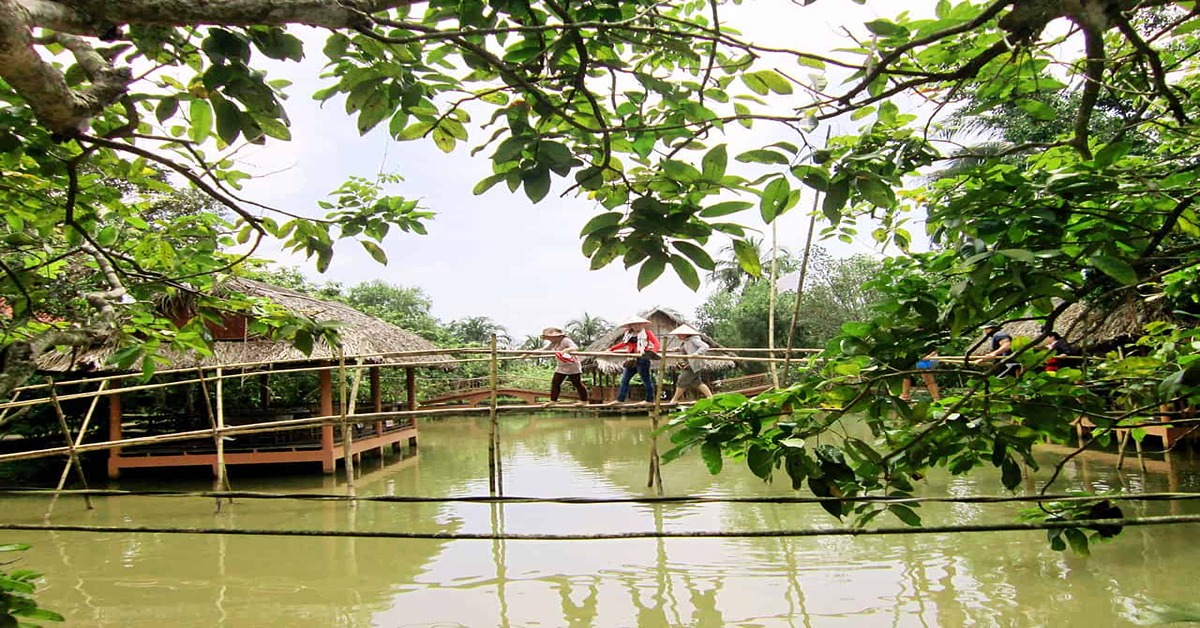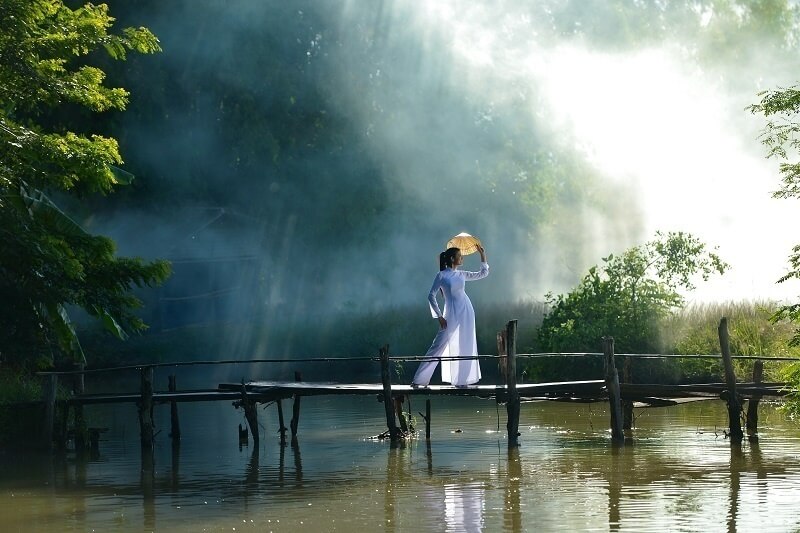
Where to find monkey bridge in Vietnam?
Want to experience a unique and thrilling adventure in Vietnam? Look no further than its iconic monkey bridge. These simple yet exhilarating structures offer a glimpse into rural Vietnamese life and provide an unforgettable experience for travelers.

What is monkey bridge?
A monkey bridge, or “cầu khỉ” in Vietnamese, is a traditional, handmade, wood or bamboo walkway built across rivers or gullies in Vietnam. These bridges are often narrow, sometimes just a single log or plank, and can be quite precarious to cross, especially for those unfamiliar with them. Monkey bridges are most commonly found in the Mekong Delta, where they connect villages and farms across the intricate network of rivers and canals. They also exist in other rural areas of Vietnam, particularly in the Red River Delta.
Despite their simplicity and potential danger, monkey bridges are an integral part of life in many Vietnamese villages. They are often the only way to reach neighboring communities, schools, or markets. Locals, who are accustomed to crossing these bridges, navigate them with ease, often carrying heavy loads or riding bicycles.
For tourists, crossing a monkey bridge can be a thrilling and memorable experience, offering a glimpse into the unique challenges and ingenuity of rural Vietnamese life. However, it’s important to exercise caution and follow local guidance when crossing these bridges.
The History of Monkey Bridge in Vietnam

Origins and Evolution of monkey bridge
The exact origins of monkey bridges in Vietnam are unclear, but their existence is deeply rooted in the country’s agricultural history. As Vietnam’s riverine landscape developed, so too did the need for efficient transportation across waterways.
Early Vietnamese communities, heavily reliant on agriculture, constructed simple, improvised bridges using readily available materials like bamboo and wood. These rudimentary structures eventually evolved into the more sophisticated monkey bridges we recognize today.
A Cultural and Practical Necessity of monkey bridge
Monkey bridges have long been an integral part of rural Vietnamese life, serving as essential links between villages, farms, and markets. They are particularly prevalent in the Mekong Delta, where a complex network of rivers and canals shapes the landscape.
Beyond their practical function, monkey bridges have also gained cultural significance. They are often featured in Vietnamese literature, poetry, and art, symbolizing the resilience and ingenuity of the Vietnamese people.
A Changing Landscape of monkey bridge
While monkey bridges remain iconic symbols of rural Vietnam, their prevalence has diminished over time. As infrastructure development progresses, many traditional bridges are being replaced by more modern structures. However, in remote areas, monkey bridges continue to play a vital role in connecting communities.
The enduring legacy of monkey bridges is evident in their representation in popular culture. Lan Cao’s novel, “Monkey Bridge,” explores themes of family, identity, and the Vietnamese diaspora through the lens of a young girl’s experiences growing up in a Vietnamese village.
Activities to do at a monkey bridge

Here are some activities you can do at a monkey bridge:
1. The Thrill of the Cross:
- Walk the Plank: The most classic activity is to simply walk across the bridge. This can be quite exhilarating, especially if you’re not used to crossing narrow, unsteady bridges.
- Cycle the Bridge: For a more adventurous experience, try cycling across the bridge. This adds an extra layer of challenge and fun, but be prepared for a potential splash!
2. Immerse Yourself in the Local Culture:
- Interact with Locals: Strike up conversations with locals to learn about their lives, culture, and the significance of the monkey bridge in their community.
- Witness Daily Life: Observe how locals effortlessly navigate the bridge, often carrying heavy loads or riding bicycles. This offers a glimpse into their daily routines and resilience.
3. Capture the Moment:
- Photography: Take photos of the bridge itself, the surrounding landscape, and the local people. The unique architecture and picturesque scenery provide ample opportunities for stunning shots.
- Drone Photography: If you have access to a drone, capture aerial views of the bridge and the surrounding area. This can provide a breathtaking perspective of the bridge’s setting.
4. Embrace the Adventure along the monkey bridge:
- Enjoy the Scenery: Take in the beautiful natural surroundings, including lush greenery, serene waterways, and charming villages.
- Relax and Recharge: After the excitement of crossing the bridge, find a peaceful spot to relax and enjoy the tranquility of the countryside.
Remember to prioritize safety when crossing a monkey bridge. Wear appropriate footwear, hold onto the handrails, and be mindful of your footing. If you’re unsure, consider asking a local for guidance.
Where to find monkey bridge?
Monkey bridges are most commonly found in the Mekong Delta, but they can also be found in other rural areas of Vietnam, particularly in the Red River Delta.
Mekong Delta:
- Ben Tre Province: This province is known for its extensive network of canals and rivers, making it a prime location for monkey bridges.
- Can Tho City: This bustling city serves as a gateway to the Mekong Delta and offers opportunities to explore nearby rural areas with monkey bridges.
Phong Nha-Ke Bang National Park:
- Monkey Bridge Phong Nha: This is a popular tourist attraction located near Phong Nha National Park. It offers a unique and adventurous experience, as visitors can cycle across a narrow bamboo bridge over a small river.
Safety Tips for Crossing a Monkey Bridge
1. Choose the Right Time:
- Avoid crossing during heavy rain or strong winds, as the bridge can become slippery and unstable.
- Early morning or late afternoon can be ideal times to cross, as the weather is often calmer.
2. Wear Appropriate Footwear:
- Wear sturdy, closed-toe shoes with good grip to ensure a firm footing on the bridge.
- Avoid sandals or flip-flops, as they can easily slip off.
3. Hold On Tight:
- Use the handrails or ropes provided to stabilize yourself.
- If there are no handrails, maintain a steady grip on the bridge’s structure.
4. Watch Your Step:
- Pay attention to the bridge’s surface, as there may be gaps or uneven sections.
- Step carefully and avoid rushing.
5. Be Mindful of Others:
- If you’re crossing with others, be courteous and take turns, especially on narrow sections.
- Avoid blocking the way for those behind you.
6. Respect the Environment:
- Be mindful of the natural surroundings and avoid littering.
- Adhere to any local regulations or guidelines.
7. Consider a Guided Tour:
- Joining a guided tour can provide additional safety and insights into the local culture and history.
- Tour guides can offer advice and assistance during the crossing.
By following these tips, you can safely enjoy the unique experience of crossing a monkey bridge and immerse yourself in the beauty of rural Vietnam.
